Introduction
The financial planning process enables an individual or a family to plan for earning with an aim of converting finances to wealth. Financial planning process is used in the managing investment for an individual. Before carrying out an investment planning process, an individual needs to come up with objectives that reflect on character, lifestyle, future and goals of an individual.
Aim of the paper
In the paper, I seek to come up with the right investment decisions for my future finances. The investment will focus on investing in Exchange Traded Funds (ETFs). The ETFs are one of the most traded financial instruments in the world due to their flexibility. The essay will discuss the possibility of investing in a number of selected ETFs in connection to an investment objective of an individual.
About the Client
Currently, I am aged 50 years and married. I have a daughter who is currently a university student. My annual income after tax is $100,000. Further, I expect to retire at the age of 60. The monthly after tax income needed after retirement is 60% of my current income. This amount of income will be required until the last age of expectancy that is, 90 years. Apart from my retirement objectives, I would also like to adequately secure the college education of my children.
My current investment and risk profile
The table presented below shows the composition of my current portfolio.
Based on my current portfolio, I fall under the category of a greater-than-average risk taker because 95% my current portfolio is made up of investment in long term assets (bonds, stock, and satellite commodities and stock). It is a dynamic risk profile. Besides, I can be able to invest in some of the assets for a period longer than seven years. This portfolio will be consistent with my long term objectives. Besides, I will be able to adequately finance my expenses after retirement (Stevenson 2013). My regular investments amount to $10,000 per quarter.
Factors to consider when coming up with an asset allocation and an investment plan with my time horizon
There are a number of factors that I took into account when coming up with an my current portfolio. The first factor was my investment objectives and goals and my current financial condition. In relation to the objective factor, my main motivating factor for investing my finances is to secure my kids’ college fund in the future when they will be in a position to attend college. Moreover, I plan to live a fulfilling retirement life and thus this will include covering the major bills such as healthcare, travel and entertainment (Lydon 2009). As a result, my objectives for investing will for the long term since these needs are way advance in the future. My timing ranges from 7 to 20 years since this is the period when my children will be in college and most likely the period when I get to retire from career life. The second factor is coming up with the right asset allocation. Under this, I took into account the fundamentals and macro analysis in order to determine the best investment opportunity. Also, I took into account the historical risk adjust performance analysis (Ferri 2011). This entailed reviewing the historical returns of the various categories of investment opportunities. This should also entail evaluating the risks that are associated with the various investment opportunities. The final factor is allocating the available funds strategically to the selected assets.
Based on my assessment of risk, time and objectives, I would say that the most suitable investment options for me would be ETFs, mutual funds and cash investments (Warwick 2012). A large portion of my portfolio will be made up of ETFs because they have a number of advantages. First, ETFs have lower fees. Secondly, EFTs can provide a large exposure to a variety of market segments and group of equities. Thirdly, the ETFs trade in the financial market just like stock. Finally, the dividends that are earned on ETFs can be ploughed back instantly. The table below shows my current asset allocation.
Investment Analysis
Elements Rogers Intl Commodity (ETN)
Ticker symbol: RJI
ETN is a structured instrument that tracks 37 commodities in the futures market. It is the most diversified ETF. This ETF is designed to mimic the movements of the Rogers International Commodity Exchange which provides an exposure to commodities consumed in the global economy (James 2012). This investment instrument is one of the cheapest forms of investment. Investing in this ETF is advisable for long term investments since it is less volatile and suitable for investors with low risk appetite (Thompson 2009, p. 1132). Besides, it is cheap and it promises high returns. The prices increased from increased from a negative position of 42.43 in 2008 to a positive position of 1.29 in 2013. The year to date price for the ETF is -5.45. The rank in category declined from 34 in 2008 to 25 in 2012. The 3-year standard deviation of the EFT is 16.41 while the average return is -0.77. Further, the Sharpe ratio is 0.03 while the Sortino ratio is 0.04. The EFT is less volatile as compared to the Mornigstar long-only commodity TR. The net expense ratio and gross expense ratio for the ETF is 0.75%. The table presented below gives other information that relate to the ETF.
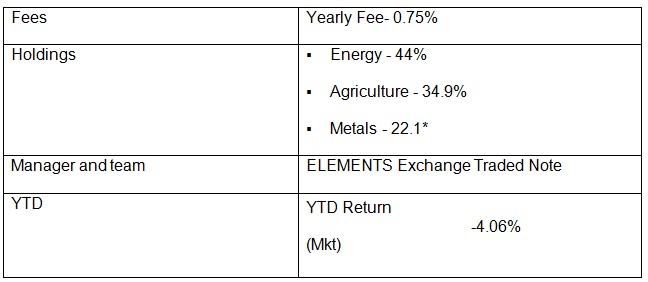
I select this ETF because it is cheap, less volatile, promises high returns, suitable for long term investment, and diversified because it tracks several commodities.
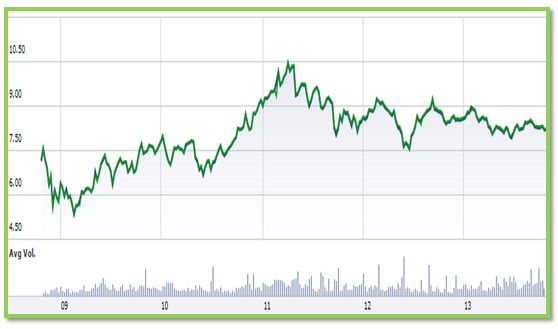
iShares Barclays TIPS Bond
Ticker symbol: TIP
The bond is one of the best investment instruments in the ETF sector due to its flexibility and potential of earnings. The bond is a protected treasury security traded fund. This secures it from frequent inflation and it safeguards the expected gain. The bond suitable for an investor with long-term goals (Ferri 2011). The price of this fund as at 28th of October, 2013 was $ 113.36 and most of the fund has been invested in the US Treasury note. In terms of performance, the bond has experienced tremendous growth. The price has gone up by 13.28% while its NAV has also increased by 13.40%. This performance is slightly better than the aggregate of other protected bonds which had an increase of 12.66% in price and 12.67% increase in NAV (Berry & Junkus 2010, p. 708-711). The overall return of the ETF is above average while the overall risk is average. The 3-year standard deviation of the EFT is 5.48 while the average 3-year return is 3.17. The 3-year Sharpe ratio of the asset is 0.58 while the Sortino ratio is 0.86. Further, statistics show that the ETF is less volatile when compared to the Barclays US Aggregate. The net expense ratio and gross expense ratio for the ETF is 0.20%. The value is higher than the average of the category (0.19%). I select this ETF because it is flexible, guarantees high returns and it is protected from the effect frequent inflation.

PowerShares DB Commodity Index Tracking
Ticker symbol: DBC
The fund is based on the Deutsche Bank Liquid Commodity Index. The fund tracks the changes of the DBIQ Optimum Yield Commodity Index. The fund tracks 14 most traded and physical commodities in the world within four sectors of agriculture, energy, industrial metals and precious metals. The fund performs well since it takes advantage of the roll yield. The current price for unit of this fund stands at $25.85 as at 25th of October, 2013. Investing in this fund is quite risky (Gitman, Joehnk & Smart 2010). However, the fund is suitable because it tracks different commodities which make it more balanced and diversified (Warwick 2012). Over the last five years, the fund’s NAV has grown by 5.81%. The overall return and risk of the EFT is average. Besides, the ETF has a three star rating. The 3-year standard deviation of the EFT is 16.82 while the average 3-year return is 0.75. The 3-year Sharpe ratio of the asset is 0.12 while the Sortino ratio is 0.17. Further, statistics show that the ETF is slightly more volatile than the Morningstar Long-Only Commodity TR. The net expense ratio and gross expense ratio for the ETF is 0.85%. The value is higher than the average of the category (0.92%).
Source of data – Morningstar Inc. 2013
I select this ETF because it is balanced and diversified since it tracks several commodities in different sectors. Also, it promises high returns since it takes advantage of the roll yield.
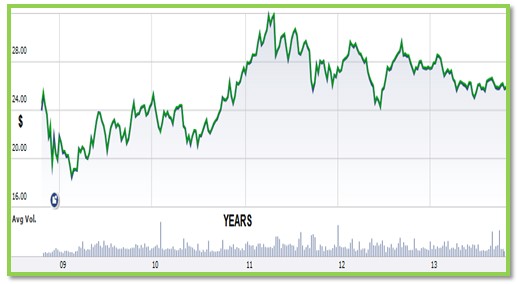
Vanguard Dividend Growth Inv
Ticker symbol: VDGIX
The fund that was designed to give investors an opportunity to earn from well performing companies that earns dividends (Rao, Pearce & Xin 2010, p. 109). The fund has a low exposure to risk. As a result, this would be a good investment for a person willing to invest in a long term fund that is less risky and quite profitable (Janjigian, Horan & Trzcinka 2011). Investment in this fund is cheap since it only requires a minimum of $ 3,000. Besides, it is based on low tax regime. The overall return of the fund is above average while the average risk is low. The fund has a five star rating. The 3-year standard deviation of the fund is 9.76 while the average 3-year return is 16.64. The 3-year Sharpe ratio of the asset is 1.63 while the Sortino ratio is 3.28. Further, statistics show that the fund is slightly less volatile and more profitable than the S&P 500 TR. The table presented below shows other information that relates to the fund.
Source of data – Morningstar Inc. 2013
I select this fund because it is less volatile, promises high returns, diversified because it tracks several commodities, based on low tax regime, and suitable for long term investment.
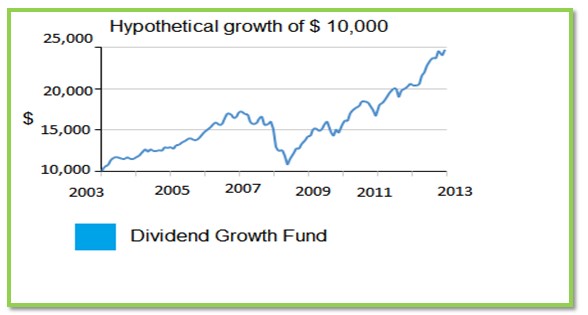
Vanguard FTSE All-World ex-US ETF
Ticker symbol: VEU
This fund is designed to track FTSE All-World ex US Index of 2,200 companies across the world. It is passively managed using a sampling of the index. This fund tracks companies which are not listed in the US and thus it offers an opportunity for investors to broaden their investments. The regional distribution is presented below.
Source of data – Morningstar Inc. 2013
This fund enables investors to get exposed to developing and emerging non-US equities around the globe (Stevenson 2013). The current unit price of this fund is $ 50.57 and its performance is quite volatile. This fund is quite risky (Clapp & Helleiner 2012, p. 187-192; Appel, Lydon & Masonson 2011). Investing in this fund will require good timing so that the investor can reap maximum benefits. The overall return of the ETF is average while the overall risk is above average. Further, the ETF has a five star rating. The 3-year standard deviation of the fund is 17.51 while the average 3-year return is 6.01. The 3-year Sharpe ratio of the asset is 0.42 while the Sortino ratio is 0.61. Further, statistics show that the ETF is more volatile and less profitable than the MSCI EAFE NR. The net expense ratio and gross expense ratio for the ETF is 0.15%. The value is higher than the average of the category (0.42%). The table presented below shows other information that relates to the fund.
Source of data – Morningstar Inc. 2013
I select this ETF because it is diversified because it tracks several commodities for 2,200 companies across the world.
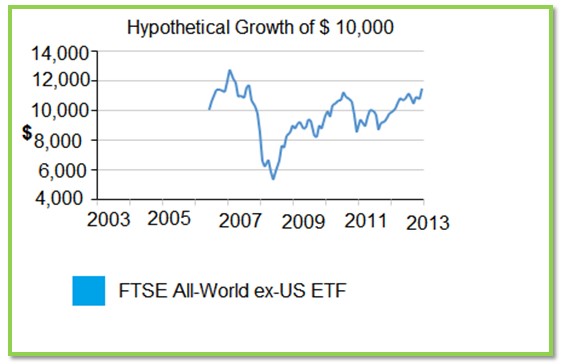
Vanguard Intermediate-Term Bond ETF
Ticker symbol: BIV
The fund is a bond that tracks the return on investment on the Barclays 5-10 year Government Adjusted Index. This fund is a market weighted bond index which covers investment grade bonds with a maturity of 5 to 10 years. This fund can also be classified as an immediate term bond. The bond has a Net Asset Value (NAV) of $84.39 as at 25th of October, 2013 (Patil 2009, p. 756-758). The fund has a dividend yield of 5.20%. The price of the fund increased by 8.51% over a five year period (James 2012). This performance can be compared to other bonds such as the Barclays US Agg-Bond TR USD that had an increase of 5.87% within the last 5 years. The overall return of the ETF is above average while the overall risk is high. Further, the ETF has a four star rating. The 3-year standard deviation of the fund is 4.58 while the average 3-year return is 3.95. The 3-year Sharpe ratio of the asset is 0.85 while the Sortino ratio is 1.37. Further, statistics show that the ETF is more volatile and more profitable than the Barclays US Aggregate. The net expense ratio and gross expense ratio for the ETF is 0.10%. The value is higher than the average of the category (0.23%). Therefore, the fund outperformed other funds and it is a good long term investment. The table presented below shows other information that relates to the fund.
Source of data – Morningstar Inc. 2013
I select this ETF because suitable for long term investment and it performed better than other ETFs in the same category.
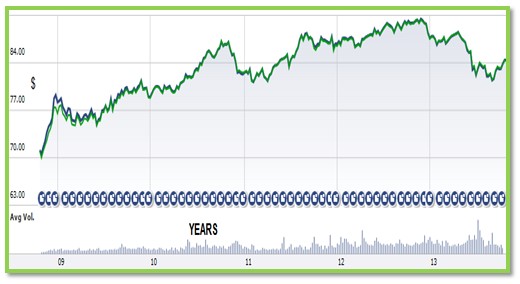
WisdonTree Emerging Mkts Small Cap Div
Ticker symbol: DGS
The fund tracks companies that are small in size in terms of capital employment. The fund is structured in a manner that takes advantage of the local companies operating in different local economies. As of 28th October, the NAV stood at $ 49.19 on the 28th October. This fund has been in the market since 2007 and its value has increased tremendously (Vikas, Narayan & Naik 2008, p. 73). In the last five years, this fund has grown exponentially with its NAV gaining 27.36 points. This represents a 127.61% increase. The overall return of the ETF is high while the overall risk is below average. Further, the ETF has a five star rating. The 3-year standard deviation of the fund is 18.87 while the average 3-year return is 1.20. The 3-year Sharpe ratio of the asset is 0.15 while the Sortino ratio is 0.21. Further, statistics show that the ETF is more volatile and less profitable than the MSCI EAFE NR. The net expense ratio and gross expense ratio for the ETF is 0.63%. The value is higher than the average of the category (0.68%). The table presented below shows other information that relates to the fund.
Source of data – Morningstar Inc. 2013
I select this ETF because it is less volatile, promises high returns, and diversified because it tracks several commodities.
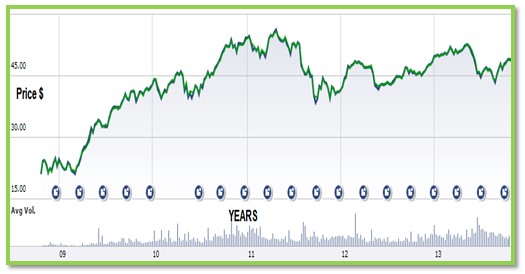
My Cash
Investing in ETF’s can be risky due to market volatility and risks associated with these instruments. Therefore, it would be prudent to invest a small portion of my savings in cash. The value of cash savings over time is eroded by inflation (Clapp 2012, p. 204). The advantage of having cash savings is that it has extremely low risk. However, most savings attracts low interest (Janjigian 2011). Investing in cash provides flexibility compared to stocks and bonds. Moreover, cash is easily available in cases of emergency. The growth in cash investments is quite slow but some offer good fixed deposit rates that can encourage an investor to avoid risk and save money through cash (Ferri 2011). For instance, if an individual saves $ 10,000 over a ten year period at an interest rate of 3%, his/her investments over the ten years will amount to $ 13,439.16. Thus, with low risk and no effort cash can be considered as a safe bet for investment.
Opinion on whether the current allocation is suitable
Based on the above discussion, it can be noted that Vanguard FTSE All-World ex-US ETF and PowerShares DB Commodity Index Tacking are quite risky. However, the other EFTs and the mutual fund offer high returns at a low level of risk. Further, the EFTs covers a variety of industries. Therefore, the current allocation can be altered to reduce the allocation of the two EFTs. The new allocation is presented in the table below.
Thus, reducing the allocation of the risky ETFs will reduce the overall risk of the portfolio.
Conclusion
Investing is very important in the achievement of the goals and objectives of any individual’s financial freedom. Due to the intricate nature of the various forms of investment tools and options, it is wise to learn the fundamentals of investing. In this essay, various investment options which are mainly made up of ETFs were discussed. However, investing in ETFs can significantly be affected by global issues such as the global economic crisis. Thus, selection of a variety of EFTs lowers such risks. As a result, the ETFs I have chosen and analysed in this essay will allow me to grow my investments and achieve my goals and objectives.
References
Appel, M, Lydon, T & Masonson, L 2011, ETF Trading and investing strategies, Lippincott Williams & Wilkins, New York.
Berry, T & Junkus, J 2010, ‘Socially responsible investing: an investor perspective’, Journal of Business Ethics, vol. 112 no. 4, pp. 707-720.
Clapp, J & Helleiner, E 2012, ‘Troubled futures? The global food crisis and the politics of agricultural derivatives regulation’, Review of International Political Economy, vol. 19 no. 2, pp. 181-207.
Ferri, R 2011, The ETF Book: All You Need to Know About Exchange-Traded Funds, Books on Demand, New York.
Gitman, L, Joehnk, M & Smart, S 2010, Fundamentals of Investing, Sage, Chicago.
James, B 2012, 7 Timeless Principles of Investing, Jossey Bass, San Francisco.
Janjigian, V, Horan, S & Trzcinka, C 2011, The Forbes/CFA Institute Investment Course: Timeless Art of Investing, John Wiley and Sons, Boston.
Lydon, T 2009, The ETF Trend Following Playbook: Profiting from Trends in Global Exchanges, Elsevier, Detroit.
Morningstar Inc. 2013, ETF – exchange traded funds. Web.
Patil, R 2009, ‘Exchange traded interest rate derivatives’, Economic and Political Weekly, vol. 38 no. 8, pp. 755-760.
Rao, A, Pearce, L & Xin, K 2010, ‘Governments, reciprocal exchange and trust among business associates’, Journal of International Business Studies, vol. 36 no. 1, pp. 104-118.
Stevenson, D 2013, FT Guide to Exchange Traded Funds and Index Funds, Penguin Books, London.
Thompson, S 2009, ‘The globalization of securities markets: effects on investor protection’, The International Lawyer, vol. 41 no. 4, pp. 1121-1144.
Vikas, A, Narayan, Y & Naik, G 2008, ‘Risks and portfolio decisions involving hedge funds’, The Review of Financial Studies, vol. 17 no. 1, pp. 63-98.
Wagner, D 2011, Trading ETFs: gaining an edge with technical analysis, Jones & Bartlett Learning, London.